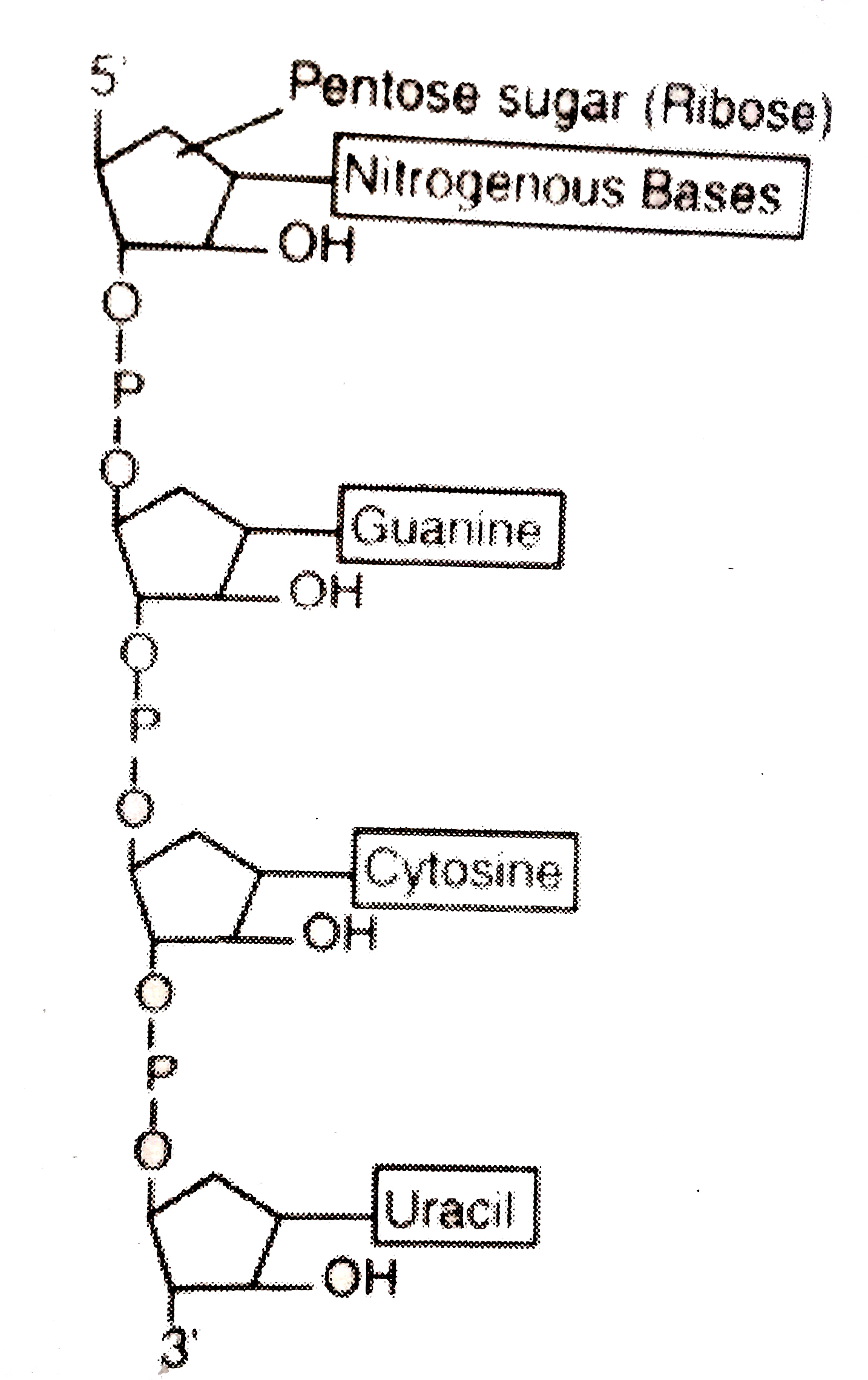At 5’ end of a polynucleotide chain
-OH group is attached
Phosphate group is attached
Pentose sugar is attached
H-bond is present
The correct Answer is:B
To answer the question "At the 5’ end of a polynucleotide chain what do we have?", we can break down the solution into the following steps:
1. Understanding Polynucleotide Chains:
- A polynucleotide chain refers to a long chain of nucleotides, which are the building blocks of nucleic acids like DNA and RNA.
2. Components of a Nucleotide:
- Each nucleotide consists of three components: a phosphate group, a pentose sugar (deoxyribose in DNA), and a nitrogenous base.
3. Structure of the Polynucleotide Chain:
- In a DNA molecule, the nucleotides are linked together to form a chain. The sugar and phosphate groups alternate along the backbone of the DNA strand.
4. Identifying the 5' End:
- The numbering of the carbon atoms in the sugar molecule is crucial. The 5' carbon of the sugar is where the phosphate group is attached.
5. Conclusion:
- Therefore, at the 5' end of a polynucleotide chain, we have a phosphate group attached to the fifth carbon of the sugar molecule.
Final Answer:
At the 5’ end of a polynucleotide chain, we have a phosphate group.
- A polynucleotide chain refers to a long chain of nucleotides, which are the building blocks of nucleic acids like DNA and RNA.
- Each nucleotide consists of three components: a phosphate group, a pentose sugar (deoxyribose in DNA), and a nitrogenous base.
- In a DNA molecule, the nucleotides are linked together to form a chain. The sugar and phosphate groups alternate along the backbone of the DNA strand.
- The numbering of the carbon atoms in the sugar molecule is crucial. The 5' carbon of the sugar is where the phosphate group is attached.
- Therefore, at the 5' end of a polynucleotide chain, we have a phosphate group attached to the fifth carbon of the sugar molecule.
At the 5’ end of a polynucleotide chain, we have a phosphate group.
Topper's Solved these Questions
- MOLECULAR BASIS OF INHERITANCEBOOK - ICSECHAPTER - MOLECULAR BASIS OF INHERITANCEEXERCISE - OBJECTIVE TYPE QUESTIONS (ASSERTION AND REASON TYPE QUESTION )
24 Videos
- MOLECULAR BASIS OF INHERITANCEBOOK - ICSECHAPTER - MOLECULAR BASIS OF INHERITANCEEXERCISE - MCQ
42 Videos
- MOLECULAR BASIS OF INHERITANCEBOOK - ICSECHAPTER - MOLECULAR BASIS OF INHERITANCEEXERCISE - REVIEW QUESTIONS
11 Videos
- MICROBES IN HUMAN WELFAREBOOK - ICSECHAPTER - MICROBES IN HUMAN WELFAREEXERCISE - COMPETITION CORNER (OBJECTIVE TYPE QUESTIONS (ASSERTION AND REASON TYPE QUESTIONS))
15 Videos
- ORGANISMS AND POPULATIONSBOOK - ICSECHAPTER - ORGANISMS AND POPULATIONSEXERCISE - COMPETITION CORNER (ASSERTION AND REASON TYPE QUESTIONS)
22 Videos
Similar Questions
The nucleases Cleaving nucleotides one at a time from the end of the Polynucleotide chain are :
View SolutionDescribe the structure of a RNA polynucleotide chain having four different types of nucleotides.
View SolutionDescribe the structure of an RNA polynucleotide chain having four different types of nucleotides.

View SolutionWhich one of the following hydrolyses internal phosphodiester, bonds in a polynucleotide chain
View SolutionWhich one of the following hydrolyses internal phosphodiester, bonds in a polynucleotide chain
View SolutionThe salient feature of DNA are -
(i) It is made of two polynucleotide chain
(ii) Back bone is constituted by sugar and nitrogen base
(iii) Two chain hacve parallel polarity
(iv) Bases in two strands are paired through H-bonds
(v) The two chain are coiled in a left handed fashion
View SolutionAdjacent nucleotides in a polynucleotide chain are joined by
View SolutionThe 3'-5' phosphodiester linkages inside a polynucleotide chain serve to join -
View SolutionN-glycosidic linkages in a polynucleotide chain join
View SolutionAssertion :- The backbone of polynucleotide chain is formed due to sugar and phosphate.
Reason :- A nitrogenous base is linked to the pantose sugar through a N-glycosidic linkage to formed a nucleoside.
View Solution
